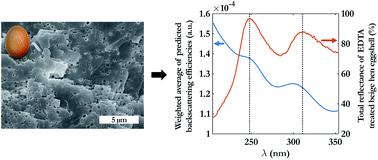当前位置:
X-MOL 学术
›
Faraday Discuss.
›
论文详情
Our official English website, www.x-mol.net, welcomes your feedback! (Note: you will need to create a separate account there.)
Scattering of ultraviolet light by avian eggshells.
Faraday Discussions ( IF 3.4 ) Pub Date : 2020-05-11 , DOI: 10.1039/d0fd00034e Mathieu Ladouce 1 , Tarek Barakat , Bao-Lian Su , Olivier Deparis , Sébastien R Mouchet
Faraday Discussions ( IF 3.4 ) Pub Date : 2020-05-11 , DOI: 10.1039/d0fd00034e Mathieu Ladouce 1 , Tarek Barakat , Bao-Lian Su , Olivier Deparis , Sébastien R Mouchet
Affiliation

|
Eggshells are essential for the reproduction of birds since the optical properties of shells may have an impact on biological functions such as heating and UV protection, recognition by parents or camouflage. Whereas ultraviolet reflection by some bird eggshells has been recently described, its physical origin remains poorly understood. In this study, we identified a porous structure in eggshells. Using Mie scattering modelling, we found it was most likely responsible for reflectance peaks (intensities of ca. 20–50%) observed in the near-UV range. These peaks were observed by spectrophotometric measurements from eggshells of several breeds of hen, one breed of duck and one breed of quail. This optical response was interpreted in terms of the distinct visual perception of hens and humans: eggshells appearing achromatic for humans proved to be chromatic for hens. Fluorescence emission from these eggs was also characterised and attributed to the presence of protoporphyrin IX and biliverdin IXα in the shells. Electron microscopy observations revealed the presence of pores within the so-called calcified shell part (i.e., at depths between ca. 20 μm and ca. 240 μm from the eggshell’s outer surface). Mercury intrusion porosimetry allowed us to quantify the pore size distribution. Simulations of the UV response of this porous structure using Mie scattering theory as well as an effective approach accounting for multiple scattering indicate that these pores are responsible for the backscattering peaks observed in the UV range, in the case of beige hen eggshells. Due to the similarities between the pore size distributions observed for beige hen eggshells and other investigated poultry eggshells, we expect Mie backscattering to be the origin of the UV response of the eggshells of many other bird species.
中文翻译:

鸟类蛋壳对紫外线的散射。
蛋壳对于鸟类的繁殖至关重要,因为蛋壳的光学特性可能会影响生物功能,例如加热和紫外线防护、父母的识别或伪装。虽然最近已经描述了一些鸟蛋壳的紫外线反射,但其物理起源仍然知之甚少。在这项研究中,我们发现了蛋壳中的多孔结构。使用 Mie 散射建模,我们发现它最有可能导致反射峰(强度约为20–50%) 在近紫外范围内观察到。这些峰是通过对几种母鸡、一种鸭子和一种鹌鹑蛋壳的分光光度法测量观察到的。这种光学响应是根据母鸡和人类的不同视觉感知来解释的:对于人类来说,看起来是无色的蛋壳对母鸡来说是有色的。这些鸡蛋的荧光发射也被表征并归因于蛋壳中存在原卟啉 IX 和胆绿素 IXα。电子显微镜观察显示在所谓的钙化壳部分(即,在约20 微米和约20 微米之间的深度处)存在孔隙。距蛋壳外表面 240 μm)。压汞孔隙率测定法使我们能够量化孔径分布。使用 Mie 散射理论以及解释多重散射的有效方法对这种多孔结构的 UV 响应进行模拟表明,在米色鸡蛋壳的情况下,这些孔是在 UV 范围内观察到的反向散射峰的原因。由于米色母鸡蛋壳和其他研究的家禽蛋壳所观察到的孔径分布之间的相似性,我们预计 Mie 反向散射是许多其他鸟类蛋壳紫外线响应的起源。
更新日期:2020-05-11
中文翻译:

鸟类蛋壳对紫外线的散射。
蛋壳对于鸟类的繁殖至关重要,因为蛋壳的光学特性可能会影响生物功能,例如加热和紫外线防护、父母的识别或伪装。虽然最近已经描述了一些鸟蛋壳的紫外线反射,但其物理起源仍然知之甚少。在这项研究中,我们发现了蛋壳中的多孔结构。使用 Mie 散射建模,我们发现它最有可能导致反射峰(强度约为20–50%) 在近紫外范围内观察到。这些峰是通过对几种母鸡、一种鸭子和一种鹌鹑蛋壳的分光光度法测量观察到的。这种光学响应是根据母鸡和人类的不同视觉感知来解释的:对于人类来说,看起来是无色的蛋壳对母鸡来说是有色的。这些鸡蛋的荧光发射也被表征并归因于蛋壳中存在原卟啉 IX 和胆绿素 IXα。电子显微镜观察显示在所谓的钙化壳部分(即,在约20 微米和约20 微米之间的深度处)存在孔隙。距蛋壳外表面 240 μm)。压汞孔隙率测定法使我们能够量化孔径分布。使用 Mie 散射理论以及解释多重散射的有效方法对这种多孔结构的 UV 响应进行模拟表明,在米色鸡蛋壳的情况下,这些孔是在 UV 范围内观察到的反向散射峰的原因。由于米色母鸡蛋壳和其他研究的家禽蛋壳所观察到的孔径分布之间的相似性,我们预计 Mie 反向散射是许多其他鸟类蛋壳紫外线响应的起源。



























 京公网安备 11010802027423号
京公网安备 11010802027423号